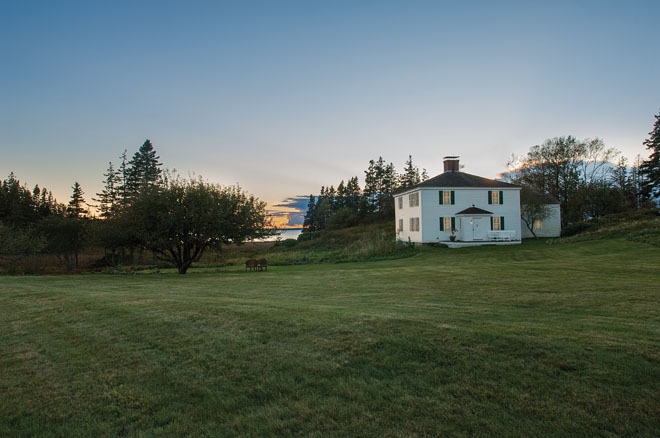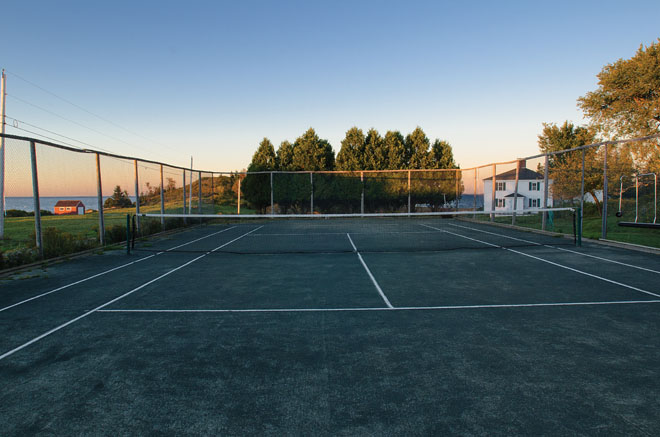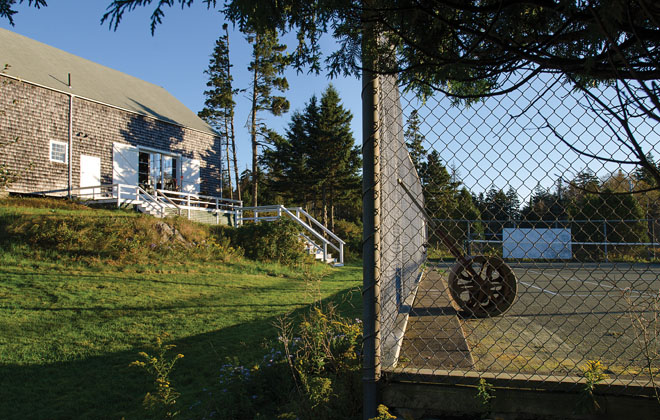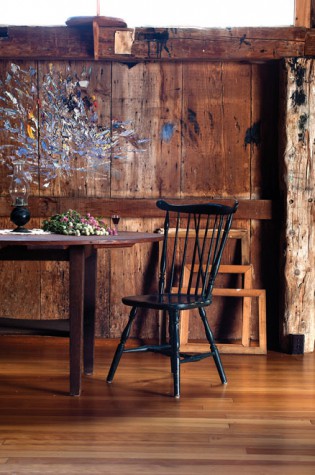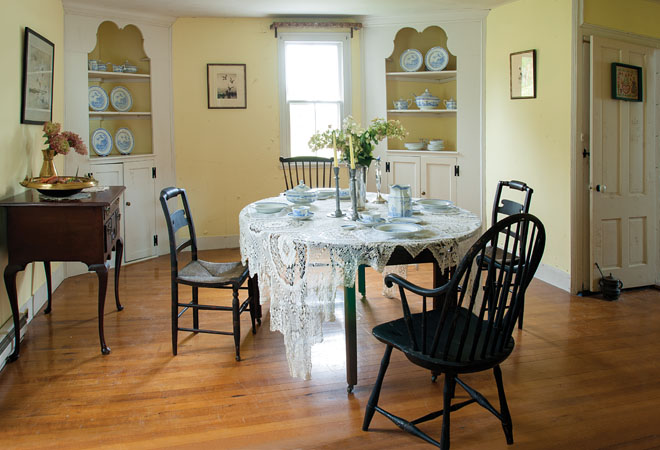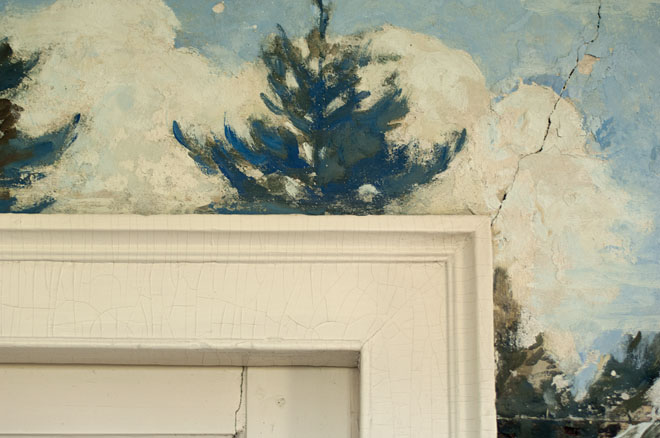Dreamy Days at Wooster Farm
FEATURE
A secret purchase extends the life of an American artist’s home.
Can a sunny day be more enjoyable than a sunny day in a Frank W. Benson painting? Somehow it doesn’t seem so. The turn-of-the-century American impressionist made a career of depicting sporting scenes, wildfowl, and members of high society, but he is best known for his portraits of his family at Wooster Farm, his summer home on the island of North Haven. There must have been rainy days in the many decades the Bensons spent at Wooster Farm, but his paintings are primarily of days of brilliant sun. Benson’s daughters are painted as girls in white dresses with high collars and cinched waists. Their hair is piled on their heads or pulled back with bows, and their pursuits seem simple: one considers a shell, another holds a basket of bright flowers, still another looks over the bow of a dory on a calm summer morning. Of Benson’s paintings a contemporary critic wrote, “I am convinced there is a little jar marked ‘Sunshine,’ into which he dips his brush when he paints his pictures of the summer. It is impossible to believe that mere paint, however cleverly laid on, can glow and shimmer and sparkle as does the golden light on his canvas.”
If you happened to see the exhibition Impressionist Summers: Frank W. Benson’s North Haven at the Farnsworth Art Museum last year, you already know some of the story of Wooster Farm. If you purchased the accompanying catalog—beautifully executed by guest curator Faith Andrews Bedford, who is also the artist’s great-granddaughter—you know even more. What still remains to be written is the story of how Benson’s spirit, as much as the actual farm, has persisted there to this day, thanks in part to Peter Allen, an investment banker whose family has summered on North Haven since 1913.
Wooster Farm had been a working farm for over a century when Benson began renting it for the season. In 1906, after several seasons there, Benson acquired the property. At the time, the property consisted of a simple farmhouse with a large central chimney and a barn that Benson subsequently partitioned to use as a studio. The sparkling water that appears in so many of Benson’s paintings was either Wooster Cove, to the rear of the house, or the Fox Island Thoroughfare, past a gentle hill at the front of the house. Benson had purposely avoided summering at some of the better-known art colonies of the day, but once settled in North Haven, he invited the sculptor Bela Pratt—his colleague at Boston’s School of the Museum of Fine Arts—to visit. Pratt soon purchased a house of his own at Bartlett Harbor, to the immediate north of Wooster Cove. Not long after, Pratt brought his assistant, Frederick Warren Allen, for a visit, and his assistant bought a house at Bartlett Harbor as well.
Fredrick Warren Allen was a generation younger than Benson. He was also Peter Allen’s grandfather. “My grandfather greatly admired Frank W. Benson,” Allen says. “They were both naturalists and artists.” And hard workers. At Wooster Farm, Benson painted mornings then spent afternoons with his family playing games like Kick the Can, Beckons Wanted, and Fatman’s, a special kind of baseball. Even when he wasn’t working, Benson was industrious. He made his own bow and arrow for archery competitions and a hand-carved one for each child according to his or her strength and size. He built a porch and curved bench for the front of the house. A summer diary that the family kept from 1907 until 1941 details visitors to the house, repairs made, fun had. There are exuberant discussions of the garden, of fishing triumphs (“This will be known as the great mackerel year!”), and of birds befriended. (Son George kept a crow and osprey as pets each season.) Even disappointments are mild. In 1932 Benson wrote, “Cook ran away and left us and we got a better.”
Benson, his family, and later his grandchildren spent summers at the house, but eventually Benson became too old to visit. In 1951 Wooster Farm passed into the hands of the Strong family. (Alice Trowbridge Strong, a friend of Benson’s youngest daughter, was a former student of Benson’s who rented at Bartlett Harbor.)
As for the Allen household, it also changed hands. Of Frederick Warren Allen’s five children, Frederick Graham Allen seemed the most interested in Maine, so he received the house.
Enter Peter Allen, a little boy who loved biking and tennis and visiting Bartlett Harbor. He came to feel that the island was “his foundation,” the place where he belonged, where he was most at peace. And he felt this even as he grew up, attended Yale, had children, and eventually settled in Los Angles. Which is why, when the Benson-Strong house came onto the market, Peter Allen bought it.
“I bought it as a tribute to Frank Benson’s spirit, because if he hadn’t come to Maine, I wouldn’t have come to Maine, and I bought it to honor my parents,” Allen says. (On several occasions, his father had jokingly said, “You should buy that place for the family.”)
Allen kept his ownership a secret in order to have a special unveiling. Everyone on North Haven knew the property had been sold, but no one (save the realtor and the Strongs) knew who had done the buying. Finally, one day while some members of his family were visiting Bartlett Harbor, Allen said to his daughter Alexandra and to his parents, “Let’s go to lunch.” Everyone agreed, but his father said he wanted to stay home to do the crossword puzzle. After lunch, Allen tried again. “Let’s go for a drive,” he said. Now his daughter didn’t want to go. He whispered in her ear, “I really want you to come. I want to show you an art collection.”
It’s possible to walk from Bartlett Harbor to Wooster Cove, but the family drove. They went out from Bartlett Harbor, down the road, up the Benson driveway, past the tennis court (that Benson installed in 1907), past the barn, and to the front door. The Allens had never been in the house before. Peter himself had bought the house without having ever seen the interior or doing an inspection, thinking the secret would be ruined if people saw him around the house. The family went first into the sitting room, where the walls were painted with murals. (In 1908 Benson had written in his summer diary, “Wall paper and ceiling of sitting room tattered and torn, so we tore it off as soon as we were settled. Decided to paint frescoes on the walls of scenes about North Haven.”) One of the few interiors of Wooster Farm that Benson painted is of his daughter Elisabeth in this room, sitting before the fireplace on a rainy day.
Then the family entered a back parlor painted a robin’s-egg blue. They crossed through a ground-floor bedroom in which Mrs. Strong had installed a white, gray, and green Swedish ceramic stove. The family continued upstairs past the bedrooms with their wood walls painted white and past the white dressers, tables, and chairs, some of which may have been there since Benson’s time. Allen was overcome with feeling, moved by all the years of history that he sensed, as he walked over the creaking floors and through the low-ceilinged rooms. Finally, the family arrived at the part of the house where Frank Benson’s traveling trunk was stored. Allen’s father said, “What’s this I hear about someone buying this house?” Allen turned toward his father. His father approached him, put his index finger on Allen’s heart, and said, “It wasn’t you, was it?” “I smiled and laughed,” Allen says. “He hugged me. It was like the Sistine Chapel. The great touch. It was one of the happiest moments of my life.”
Perhaps surprisingly, Allen doesn’t live in the Benson house. He still occupies the Bartlett Harbor house that his grandfather and father tended so carefully through the years. Although Allen rents the Benson house to vacationers, his focus for the moment is on stewardship. He plans to continue the Strongs’ tradition of lovingly preserving the property. The Strongs kept Benson’s old easels and lithograph stones, which are still stored in the barn. They didn’t tamper with the interior barn walls, on which Benson liked to blot his paintbrushes; the colors most often seen in Benson’s paintings—sky blues, grays, oranges, whites, and yellows—are thickly smudged on the wood under a big window that Benson installed for the light. The Strongs used to have square dances, concerts, and weddings in the barn. Allen plans to do the same, while making the house available for those who might want to visit. “It will be an open, living museum,” Allen says. “A living and breathing tribute to Frank Benson.” And although Allen wouldn’t say so, it will also be a tribute to his big-hearted embrace of his father’s dream.
